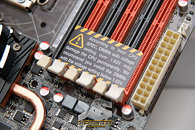- Joined
- Oct 9, 2007
- Messages
- 47,895 (7.38/day)
- Location
- Dublin, Ireland
| System Name | RBMK-1000 |
|---|---|
| Processor | AMD Ryzen 7 5700G |
| Motherboard | Gigabyte B550 AORUS Elite V2 |
| Cooling | DeepCool Gammax L240 V2 |
| Memory | 2x 16GB DDR4-3200 |
| Video Card(s) | Galax RTX 4070 Ti EX |
| Storage | Samsung 990 1TB |
| Display(s) | BenQ 1440p 60 Hz 27-inch |
| Case | Corsair Carbide 100R |
| Audio Device(s) | ASUS SupremeFX S1220A |
| Power Supply | Cooler Master MWE Gold 650W |
| Mouse | ASUS ROG Strix Impact |
| Keyboard | Gamdias Hermes E2 |
| Software | Windows 11 Pro |
Nehalem does promise to be a processor to look out for, it would be Intel's next installment, post the successful Core 2 series processors. This time however, Intel made a core modification with the way the system handles memory. The Bloomfield processors house a massive 192-bit wide memory controller for supporting tri-channel DDR3 memory. It however was found that the controller could bring in limitations to the DIMM voltages that the system could support.
The retail version of ASUS P6T Deluxe OC Palm Edition motherboard was unboxed by XFastest. Being the retail product, as usually, it comes with precautionary labels attached to parts of the motherboard. The one that covers the 6 DDR3 DIMM slots reads:

It could have implications on the current DDR3 memory market as well as you, if you happen to have DDR3 modules, which you plan to retain for use in the future platform, that operate above the said voltage. It also means that in the near future, we could be seeing memory sticks that facilitate overclocking at much lower voltages. From a technology standpoint, companies such as Samsung, Elpida, Micron, etc., are working on releasing DRAM chips based on newer silicon fabrication technologies, that operate at lower voltages.
View at TechPowerUp Main Site
The retail version of ASUS P6T Deluxe OC Palm Edition motherboard was unboxed by XFastest. Being the retail product, as usually, it comes with precautionary labels attached to parts of the motherboard. The one that covers the 6 DDR3 DIMM slots reads:
According to Intel CPU SPEC, DIMMs with voltage setting over 1.65V may damage the CPU permanently. We recommend you to install DIMMs with voltage setting below 1.65V.

It could have implications on the current DDR3 memory market as well as you, if you happen to have DDR3 modules, which you plan to retain for use in the future platform, that operate above the said voltage. It also means that in the near future, we could be seeing memory sticks that facilitate overclocking at much lower voltages. From a technology standpoint, companies such as Samsung, Elpida, Micron, etc., are working on releasing DRAM chips based on newer silicon fabrication technologies, that operate at lower voltages.
View at TechPowerUp Main Site



 all the current DDR3 ram is useless now, as most is 1.8V+
all the current DDR3 ram is useless now, as most is 1.8V+
 .
.



